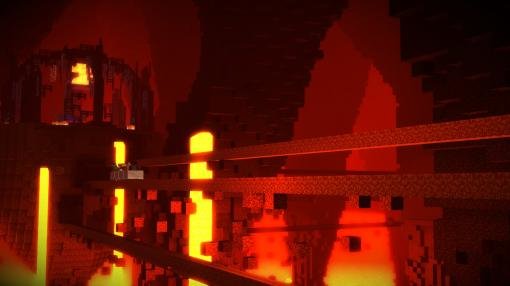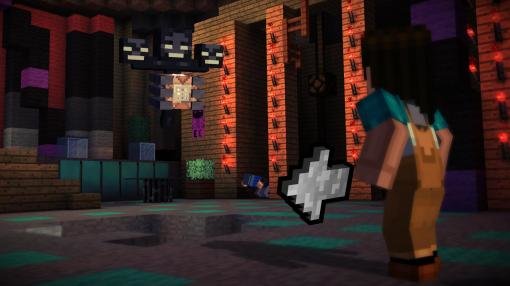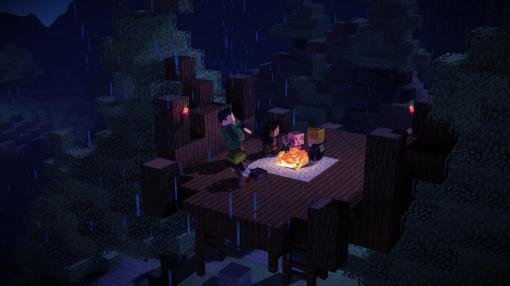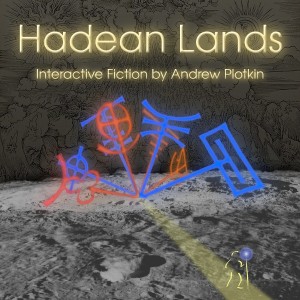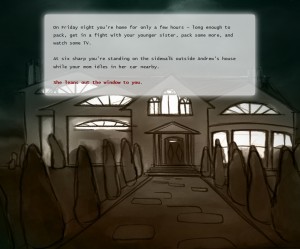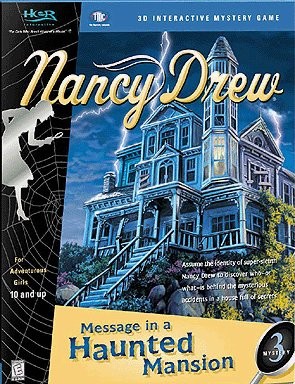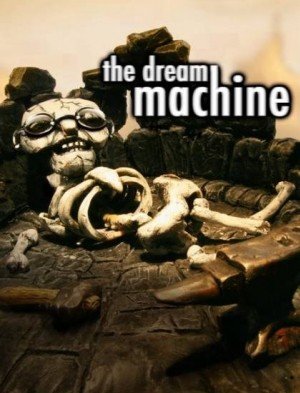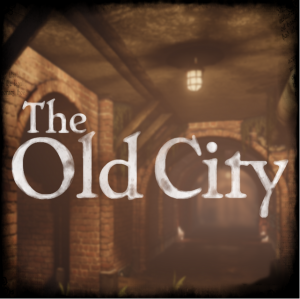Minecraft: Story Mode - Episode 1: The Order of the Stone archived preview
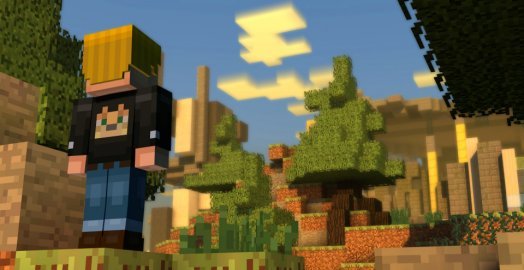
A fabulously popular open-world construction game has just made contact with the talented writers at Telltale Games, and the result is Minecraft: Story Mode. The original Minecraft was created by Markus Persson and further developed by Mojang before being released in 2011. With its emphasis on exploring, crafting and building, Minecraft was basically narrative-free – that is, until Story Mode came along. In the debut entry of a five-episode season, Minecraft’s trademark color-saturated, angular gameworld now zings with fast-paced, choice-driven dialog, Quick Time Events, and a gang of fresh-faced hero wannabes.
Episode 1: The Order of the Stone opens with the saga of four legendary heroes, members of the titular Order who once fought the Ender Dragon and then faded into obscurity. We then meet some current-day “heroes”: Olivia the technically-inclined geek, Axel the diamond in the rough, Jesse the player character – bursting with enthusiasm – and Rueben, Jesse’s pig. They are about to head to the Endercon building competition, where they will go up against the Ocelots, a team that always beats them. But this time things will be different… Or so they hope. Little do they realize that the competition will be overshadowed by a crisis with Reuben, a shady back alley deal, and a guest appearance by a mysterious member of the Order of the Stone. It soon becomes clear that there’s more to the legendary heroes than was written in the sanitized pages of history, and our heroes accidentally become involved in an unfolding disaster.
If you haven’t previously dabbled in Minecraft, it’s important to know that the gameworld is constructed of tiny, unpolished cubes – in the first episode, the 3D block-based locales start out modest with settings like a stage with columns, a treehouse, and a basement full of artifacts. Later on, they expand to monumental structures in fantastical scenes: an underground world of rocks and lava, a multi-level stone temple, a bridge over a canyon with zombies at one end and creepers at the other. Minecraft familiarity will add some context to the Story Mode experience – having already encountered the monsters that haunt these environments, you will have an idea of what they are capable of, for instance. But it is not at all necessary to play the original game in order to enjoy this new series.
Like the gameworld, the characters are formed out of small, colorful bricks. They look somewhat like Lego figures, though less shiny-plasticky and more pixelated, like 1980s adventure characters blown up into high-res widescreen 3D. Individual faces are distinguishable by different skin and hair color, eyebrow shapes, hats and scarves. Facial expressions are basic but effective. The game is played from a third-person perspective, and body animation is reasonably smooth, given that the characters are made from blocks stuck together with a few joints. Adding significantly to the characters’ distinct personalities are the professional voice-overs, both from Telltale regulars and familiar Hollywood talent like Corey Feldman, Paul Reubens, and Patton Oswalt as the male lead.
The interplay between characters ranges from comfortable camaraderie between Endercon team members (including silly jokes), to nasty asides on the part of competitors, to tense disagreements and varied reactions in the face of stress, danger, and decision-making angst. Dialogs are snappy and reveal much about personalities and motives. Sometimes I chuckled, sometimes I groaned, and sometimes I held my breath. Virtual strangers join the team for parts of the journey, and these temporary members create conflicts and ambiguities that run their course one way or (if you play through a second time and make different choices) another.
Well-integrated cutscenes augment the gameplay scenarios with hints about ongoing threats, revelations about the environment, explanatory chats that provide backstory, and stints of plummeting, hurdling, and bouncing. Distinctive ambient sound – the rustling of bushes, whisper of eerie voices, and chirping of crickets – contributes to the atmosphere. In the same way the music, consisting of drawn-out electronic tones and vibrations, quickening rhythms, and lively plucked tunes, adds greatly to the mix.
Dialogs choices are abundant; during group conversations they pop up every couple of minutes. You have a few seconds to read three lines of text options and choose amongst them as to what your character will say (you can also opt to say nothing). The frequency of these timed choices keeps you on your toes and feeling utterly involved. It also increases the pace considerably when compared to the lengthy passages sometimes found in traditional adventure game dialog trees.
Certain choices are salutary and don’t impact much, but others do make a difference. Often you realize this when the game informs you that a certain character will remember what you said. But other times you’re immediately aware that your decision mattered because it affects the action that follows. Important judgments include selecting whom to save from a rampaging monster, casting your vote on whether the gang should split up or remain together, and decreeing how to treat a frenemy. At the very beginning of the game, you also choose your character’s gender and appearance, and while this does involve a different voice actor for the male and female Jesses, it does not alter events in the game.
If you enjoyed Telltale’s earlier games but have been avoiding their later work because of its mature and/or violent themes, Minecraft: Story Mode is your chance to finally see their new story-driven approach rather than puzzle-solving gameplay. (In fact, this initial episode contains exactly one traditional adventure game puzzle – a color pattern sequence.) This is mostly a family-friendly game, the only exceptions being the occasional use of mild expletives and some cartoon-style combat. Since this series will appeal to children, however, it might be more of a concern that the text must be read so rapidly that the younger ones won’t be able to keep up. An option to slow down the dialog decisions would have addressed this issue.
One particular oddity is that the opening credits only show up about half an hour into the game. At first I thought they were ending credits and that The Order of the Stone was over in very short… well, order. Fortunately the game continued for a good two hours after that.
Non-dialog-based gameplay consists of short bursts of free exploration, crafting, Quick Time Events and combat. At various times (slightly more frequently than in Telltale's other recent offerings) you'll get the opportunity to do some standard adventuring, roaming around self-contained environments, interacting with hotspots and picking up an item or two. There's nothing complicated about these sequences, and there are options for how visibly you want hotspots highlighted by default. Crafting tasks surface a few times during such scenes. In these activities, you simply combine items carried in inventory at a crafting table to produce a tool that will help bypass upcoming obstacles. Explicit recipes are provided for each item you craft, eliminating the need for any thought, though you don't have to refer to them if you'd rather approach crafting more like a conventional inventory puzzle.
The QTEs employ rapid button-tapping, dodging obstacles via on-screen prompts, or grabbing onto something at just the right moment. Combat requires swinging a sword as fireballs or zombie fists are repeatedly aimed at you. It’s possible to die during these sequences, but the game takes you back to the point immediately before you expire. In the opening episode, these encounters are reasonably challenging but not intensely so. I’m not quick-reflexed, but I only had to repeat a couple of them two or three times to get them right. (I’m expecting the difficulty level to ramp up somewhat in later episodes.) The most frustrating QTEs occur during building cutscenes, not because they’re too hard, but because I wished to watch the characters creating huge configurations from scratch; instead I had to focus on mindless button-mashing.
I played The Order of the Stone twice – once on the PS4 and (selecting different choices) once on the iPad. Though the story, characters, and challenges are the same, the platforms granted a somewhat different experience. Playing on the PS4 was more immersive in terms of exploring the environments. Each locale seemed huge, with complex subtleties in color, requiring many steps to get through them. On the other hand, this game’s stylized blocky graphics perfectly suit the iPad’s small screen.
The interface on the iPad is simplified. All interactions are handled via tapping and swiping – in contrast to the PS4 interface, which seems grooved to ensure that you manipulate as many controller doohickeys as possible. (The PC version has gamepad support as well, along with a keyboard option.) For example, in the hand-held version you don’t have to aim the crosshairs and then press a button; instead you just tap. In addition, the iPad’s dialog choices are displayed against a solid backdrop rather than a transparent banner-strip that merges with the backgrounds. The result is that the iPad’s choice-driven texts are easier to scan – a significant advantage when you have to read quickly. The game uses autosave only, and each platform contains four slots for saving the progress of individual playthroughs.
At game’s end, a final screen lists the most important choices posited over the course of the story, and lets you know the percentage of other Order of the Stone players who made the same decisions. I was surprised at how balanced most of the numbers were – though it’s possible that many gamers have chosen to replay to savor the alternatives. I enjoyed my second romp through this vividly-fashioned gameworld as much as the first, which is a tribute to its overall strength. If you are up for an adventure with appealing characters, razor-sharp script and rapid decision-making, you might want to give it a whirl. Even as I write this, Episode 2: Assembly Required has been issued right on the heels of the first. Here’s hoping that Minecraft: Story Mode’s release schedule will continue to succeed in mimicking the game’s upbeat, spanking pace.




